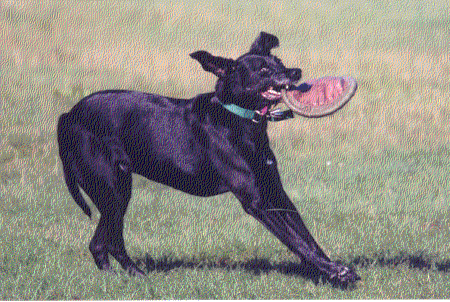This article is courtesy of https://yourdogadvisor.com/train-dog-spin/ and Jennifer Stark at Happy DIY Home (HAPPYDIYHOME.org) and is gratefully received.
NOTE: Pictures have been changed for simplicity. Thank you! These ideas are wonderful to use with our precious deaf dogs. Always remember that the only difference between our hearing and deaf dogs is the method of communication.
Creating an Effective Lure
Whether you are training for obedience-centered commands like sit and stay or fun tricks like roll over and wave, luring is one of the most common methods of getting dogs to perform different behaviors. However, if you are new to positive reinforcement training or new to training altogether, you may not be familiar with what a lure is.
Think of luring as greyhound coursing, just in a much more condensed form. Your hand is the fake rabbit that needs to move in a way that will get your dog to walk, jump, spin, or roll in the exact way you want them to.
In more traditional, outdated forms of training, dogs were forced to perform certain behaviors through a few different techniques. The most common was body manipulation. One simple example of this would be pushing on the dog’s bum to get them to sit.
Negative punishment is another way trainers used to get their dogs to do what they wanted. If the trainer wanted the dog to heel, for instance, they would use a choke chain and leash to make the dog uncomfortable any time they were out of position. The only way to escape that discomfort was to walk by the handler’s side.
These same behaviors can easily be accomplished through a much simpler, more positive way of training known as luring. And because luring doesn’t cause anxiety or pain, it allows dogs to learn behaviors much more quickly and perform them more reliably in the future. And since the dogs have to complete the movements themselves instead of being manipulated into different positions, they are more likely to connect the behavior with the command.
Luring involves using a treat or toy to entice your dog into different positions, much like using a carrot to lure a horse into their stall. While the concept itself is very simple, creating an effective lure does take a little knowledge and practice.
Keep Your Dog Interested
The perfect lure involves pulling your dog along by the nose using a high-value reward that they want to follow. Of course, they aren’t following the reward just for fun, they are following it because they want to eat or play with it.
Some dogs are highly motivated by toys while others only care about treats. Play with different items to see which will work the best for luring your dog.
If you are constantly pulling the lure out of your dog’s reach, they are likely to quickly give up on following it. Since you can’t lure your dog with something they won’t follow, you have to keep them interested in the reward. There are two key ways you can accomplish this.
First, make sure you choose a treat or toy that your dog gets very excited about.
Consider this: Your friend offers you a piece of gum. When you reach for it, they snap their hand back and laugh. What do you do? You probably give them a dirty look and walk away without the gum. But what if your friend offered you tickets to see your favorite band in concert, and then snapped their hand back when you reached for them. What would you do? Keep trying to get them, probably. Maybe even tackle your friend and pry them out of their hands.
That’s close to the reaction you want your dog to have when you present them with the lure.
The second way to keep your dog interested is to keep your lures short and reward your dog frequently by giving them the treat or letting them play with the toy. This not only keeps your dog from thinking you are just tricking them, but it also keeps them motivated to keep training.
If you are teaching your dog to walk nicely on leash, for instance, instead of luring them to walk by your side the full length of the room and then rewarding them, reward them every few feet. As they get the hang of the behavior, slowly increase the distance between rewards.
Don’t Let Your Dog Get Hyper-Focused
While an enticing lure is key, at the same time, you don’t want your dog to become too focused on it. If all your dog can think is, “Oh man, oh man, I need to get that treat, I need it right NOW!” then they are going to struggle to learn whatever you are trying to train them. You may be able to lure them into position, but if all they are thinking about is the lure, they probably didn’t even notice they moved.
There is such a thing as being too ball motivated. If your dog loses their mind every time you break out the tennis ball or the hot dogs, find something a little less valuable to use during training.
If your dog is constantly trying to chew the lure out of your hand or jumping on your arm to get control of it, you may need a slightly less valuable lure. Play with different types of treats and toys. You may even want to use different types of lures for harder behaviors and easier ones.
If your dog is right on top of your lure, you may also need to move your hand faster or hold it slightly above or below their mouth to create a tiny bit of distance. This will help them stay more aware of their own movements and should increase how quickly they pick up new behaviors.
How to Remove a Lure
Just when you get your lure down for a new behavior, it’s usually time to get rid of it. As frustrating as that is, it is an important step to getting your dog to complete a behavior from a simple cue rather than exaggerated hand movements. Unfortunately, this can be one of the most difficult pieces of lure training.
Timing is Everything
The first step to successfully removing your lure from the new behavior is to pinpoint the right time to start removing it.
If you remove the lure too early, your dog is going to get confused and start offering rough approximations of the behavior you want. Removing the lure too early on your dog’s rollover is likely to lead to a dog that lays down and puts their head awkwardly on the floor and then jumps up looking for a treat.
Pay attention to your dog as you train. Are they completing the behavior because they understand what you are asking? Or are they just following your lure? Use the lure as long as your pup needs it, but fade it out as soon as they are ready.
If you remove it too late, not only have you wasted some prime training time, but your dog may become too reliant on the lure.
The best time to start removing the lure is when your dog seems to be anticipating the behavior. They might show this by moving faster than the lure, or by focusing less on it. For instance, if you are teaching your dog to sit and suddenly they are plopping their bum down as soon as you start to lift your hand up, they are ready to say goodbye to the lure.
Fading Your Lure
There are a few different techniques you can use to get rid of or “fade” a lure. You may find that some work better for your dog on certain tricks or that you need to use multiple techniques on one behavior. You won’t know exactly what’s right for your dog until you try different methods.
In many cases, you might find that running through the full lure, but doing it quicker will help reduce your dog’s need for the lure. If you are working on roll over and your dog is ready, you might quickly drop your hand to the ground to get them to down, wait for them to catch up, then quickly circle your hand over their head to get them to roll.
Your dog won’t be able to follow the lure the whole time, but it will provide enough of a guide to get them moving in the right direction. As they are able to do more and more of the trick by themselves, you can complete the lure quicker and quicker.
Luring may sound complicated, but with a little practice, just about anyone can do it successfully.
You can also try removing the end of the lure and letting your dog complete the behavior on their own. If you are teaching your dog down, for instance, you would bring the lure to their nose as they sit and begin dropping your hand to the ground, but stop short of pulling your dog into a down. With each repetition, you can remove more and more of the lure until you are hardly moving your hand at all.
For some behaviors, the best way to fade the lure is to just stop doing it all at once. This doesn’t work in all situations but can be effective in the right ones. For instance, you might find that your dog gets overly focused on the lure during the training for spin. If that happens, it can be very difficult to fade the lure because your dog will try to follow it no matter how fast it goes or when it stops. That can result in half spins or spins that start in one direction and end going the other.
In a case like this, you may want to simply present your dog with a reward then stand there ignoring them until they offer the behavior you want. It may take a few minutes for them to offer the right one, but, since they were just being rewarded for it, they should eventually give it a shot.
>>>Trick training is a great way to stimulate a high energy dog. Here are more great tips for surviving a hyper pup.
As an additional note for our deaf dogs; our deaf dogs are incredibly smart and loving. They want to be loved and accepted just like any other pup. With wonderful care and understanding, our deaf dogs can become wonderful family members.




